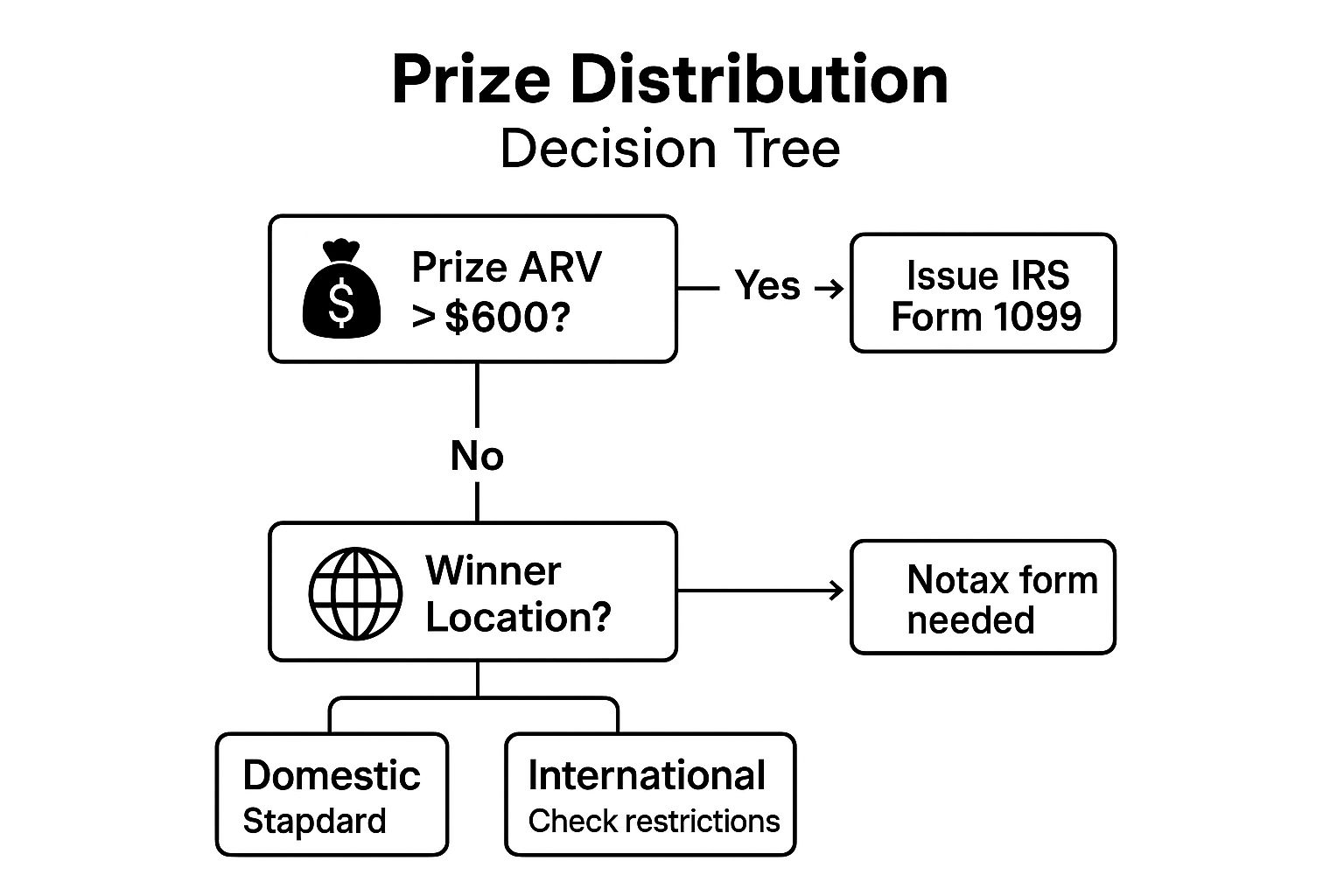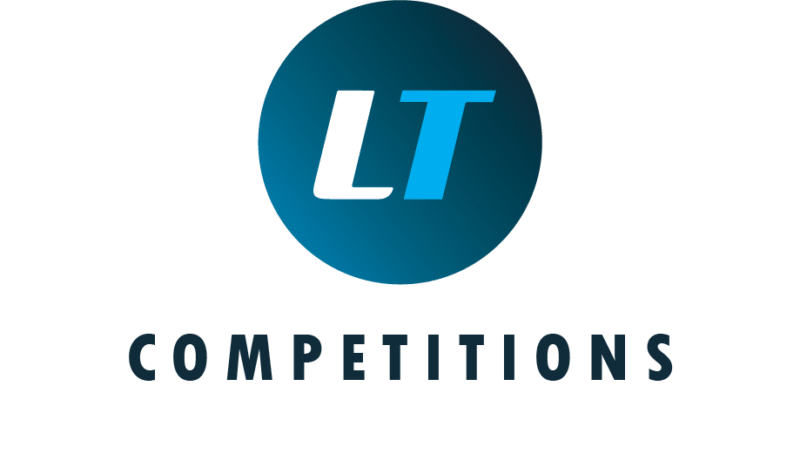Why Your Competition Needs Iron-Clad Rules
Running a competition without clear, comprehensive rules is a significant risk. Well-crafted terms and conditions are the bedrock of any successful contest, protecting your brand from legal challenges, ensuring fairness for all participants, and building crucial trust with your audience. Ambiguity in your rules can quickly lead to public disputes, difficult disqualifications, and lasting damage to your business's reputation. A robust set of regulations isn't just a legal formality; it's a strategic tool for managing expectations and ensuring a smooth, positive experience for everyone involved.
This guide moves beyond generic advice to provide a detailed contest rules example for every critical clause you need. We will dissect the most important components of any competition's legal framework, from eligibility and entry methods to prize distribution and intellectual property rights. For each example, we will analyse its strategic purpose and offer actionable insights you can immediately apply. Our goal is to help you craft rules that are both legally sound and strategically smart, ensuring your next giveaway is a resounding success. This level of transparency is vital for any competition, building the customer trust necessary for long-term engagement.
1. Eligibility and Entry Requirements
The cornerstone of any legally sound and strategically effective competition is the Eligibility and Entry Requirements clause. This foundational section explicitly defines who is permitted to participate, setting crucial boundaries that protect the organiser from legal complications and ensure the contest reaches its intended audience. Without clear eligibility rules, a promotion can quickly become unmanageable, attract ineligible entrants, and even violate regional laws, leading to significant penalties.

This part of your terms and conditions is non-negotiable for compliance and targeting. It typically covers age, geographical location, and professional status. For instance, a common contest rules example would be a UK-based spirits brand restricting entry to UK residents aged 18 and over, immediately aligning with local alcohol advertising standards and focusing marketing efforts on their primary consumer base.
Strategic Breakdown and Analysis
Defining eligibility is not just a legal formality; it's a strategic tool. By limiting participation, you can concentrate your promotional budget and sharpen your marketing message.
A classic example is McDonald's Monopoly game, which explicitly restricts participation to residents of specific countries (e.g., USA, UK) in their respective versions. This geographic fencing is critical due to differing prize structures and legal regulations in each market. Similarly, many global brands like Coca-Cola often exclude regions such as Quebec from North American contests because of the province's stringent laws governed by the Régie des alcools, des courses et des jeux, which require contest registration, security deposits, and translation, making inclusion costly and complex.
For skill-based competitions, like a photography contest, rules might exclude professional photographers. This strategy levels the playing field, encouraging more amateur and hobbyist participation, which can foster a stronger sense of community and increase engagement from the brand's core target demographic.
Actionable Takeaways
- Consult a Legal Professional: Before launching, especially for contests crossing regional or national borders, engage legal counsel. They can highlight specific regulations, like the Quebec example, that could derail your campaign.
- Be Upfront and Clear: Place eligibility rules prominently at the beginning of your terms. Use a clear, numbered list for restrictions (e.g., age, residency) to avoid ambiguity and participant frustration.
- Justify Exclusions: When excluding specific groups (like employees or professional artists), briefly explain why. A simple statement like, "to ensure a fair and equitable competition for all our customers," can maintain goodwill.
- Leverage for Targeting: Use eligibility criteria to hyper-target your ideal customer. If you're a local business, restricting entry to local postcodes ensures that every participant is a potential long-term customer.
2. Entry Methods and Submission Guidelines
The heart of any competition lies in its Entry Methods and Submission Guidelines. This section is the operational manual for participants, detailing precisely how to enter, what to submit, and any technical constraints they must follow. Unclear or overly complex entry mechanics can deter participation, create judging inconsistencies, and ultimately undermine the contest's success. A well-defined process ensures fairness, standardises submissions for easier evaluation, and guarantees a smooth user experience.

This part of your rules dictates the actions users must take, shaping both engagement levels and the quality of entries. Whether it's a simple social media tag or a complex video submission, these rules are vital. For example, a popular contest rules example involves Instagram photo contests requiring users to post with a specific hashtag (e.g., #MyBrandAdventure) and tag the brand's account. This not only standardises entries but also generates valuable user-generated content and brand visibility. Exploring different methods of how to enter a competition can help organisers choose the best approach for their goals.
Strategic Breakdown and Analysis
The choice of entry method directly impacts your campaign's goals. Simple methods like 'like and follow' maximise reach and entry volume but offer low-quality engagement. Conversely, high-effort methods filter for highly invested participants.
A prime example of a high-effort, high-reward strategy was the Doritos "Crash the Super Bowl" contest. It required entrants to create and submit a full-fledged 30-second television advert. The submission guidelines were incredibly detailed, specifying video resolutions, file formats (e.g., .mov or .mp4), and content restrictions. This high barrier to entry ensured that only serious, creative individuals participated, resulting in professional-quality content that Doritos could confidently air during the Super Bowl, generating immense buzz and media value.
Similarly, a writing contest might specify a 1,500-word limit and require submissions in .docx format with double-spacing. These seemingly minor details are crucial for a fair judging process, preventing any single entry from demanding disproportionate time from the judges and ensuring all submissions are evaluated on a level playing field.
Actionable Takeaways
- Align Method with Goals: If your goal is brand awareness, use low-friction methods like hashtag entries or email sign-ups. If you want high-quality user-generated content, require more effort, such as photo or video submissions with clear creative briefs.
- Provide Clear Examples: Don't just list rules; show participants what a good entry looks like. Include a sample photo, a short video clip, or a formatted text snippet that meets all your criteria. This reduces confusion and improves submission quality.
- Test All Technical Requirements: Before launching, have your team test the entire submission process. Can you upload the specified file type and size on various devices? Does the submission form work seamlessly on mobile? This pre-launch check prevents a flood of support requests later.
- Automate Submission Confirmation: Use an automated email or on-screen message to confirm that an entry has been successfully received. This simple step reassures participants and reduces their anxiety, improving the overall brand experience.
3. Prize Structure and Distribution Rules
A meticulously defined Prize Structure and Distribution clause is vital for managing participant expectations and safeguarding the organiser against legal disputes. This section details every aspect of the prize, from its description and approximate retail value (ARV) to the methods of distribution, winner responsibilities, and substitution policies. Clear prize rules prevent ambiguity, build trust with participants, and provide a legal framework for fulfilling your promotional obligations.
The following decision tree helps organisers navigate two common logistical hurdles in prize fulfilment: tax reporting and shipping logistics.

This visualisation highlights critical decision points that have significant legal and operational implications, reminding organisers to consider tax obligations and geographical restrictions early in the planning process.
Strategic Breakdown and Analysis
Defining your prize structure is more than just listing what winners receive; it's a critical risk management and brand reputation tool. An excellent contest rules example comes from major travel competitions, which frequently include blackout dates, travel restrictions, and specify that incidentals are the winner's responsibility. This protects the brand from unforeseen costs and manages winner expectations from the outset.
Similarly, car giveaways famously and explicitly state that the winner is solely responsible for all taxes, registration, title, and insurance fees. This transparency is crucial because the tax liability on a high-value prize can be substantial, and failing to disclose this could lead to winner dissatisfaction and legal challenges. Publishers Clearing House masterfully handles this by often presenting a cash alternative, giving winners flexibility and mitigating complexities associated with non-cash prizes. This strategy not only satisfies winners but also simplifies the fulfilment process for the organiser.
Actionable Takeaways
- State All Restrictions Upfront: Be exhaustive in detailing prize limitations. For gift cards, specify any expiration dates or usage restrictions. For experiences, list all blackout dates, exclusions, and what is not included (e.g., spending money, transfers).
- Clarify Tax Responsibility: Always include a clause stating that the winner is responsible for any and all applicable taxes on their prize. For high-value prizes, strongly recommend that the winner consults an independent financial advisor.
- Incorporate a Substitution Clause: Include a statement that allows you to substitute a prize with another of equal or greater value if the original prize becomes unavailable. This provides crucial flexibility for unforeseen circumstances, a common feature in an instant win competition. You can discover more about prize management strategies.
- Provide Delivery Timelines: Manage excitement and prevent support queries by providing an estimated delivery timeframe for prizes (e.g., "Please allow 6-8 weeks for delivery after winner verification").
4. Judging Criteria and Winner Selection
The credibility of any skill-based competition hinges entirely on its Judging Criteria and Winner Selection process. This clause outlines precisely how entries will be evaluated and a winner chosen, serving as the foundation of fairness and transparency. Clear, objective, and detailed criteria prevent accusations of bias, manage participant expectations, and legally protect the organiser by demonstrating a structured, impartial selection process. Without it, a competition risks its reputation and can face disputes from disgruntled entrants.
This section is vital for establishing trust. A strong contest rules example would detail the specific scoring system, such as a 100-point scale broken down into categories like Originality (40 points), Technical Skill (30 points), and Relevance to Theme (30 points). This level of detail ensures every participant understands the path to victory and feels the contest is run equitably, which is crucial for engagement.
Strategic Breakdown and Analysis
Well-defined judging criteria do more than ensure fairness; they guide the quality and nature of the submissions you receive. By weighting certain criteria more heavily, you can steer participants toward creating content that aligns perfectly with your campaign goals.
Take a high-profile competition like America's Got Talent. The judging is not based on a single metric. The panel of celebrity judges evaluates a blend of raw talent, originality, stage presence, and audience reaction. This multi-faceted approach ensures the winner is not just technically proficient but also commercially viable and entertaining, which is the show's ultimate business objective. Similarly, prestigious photography contests often use panels of professional photographers who judge based on composition, lighting, and narrative power, ensuring the winning entries uphold a high standard of artistry.
In a corporate design contest, an expert panel might judge submissions based on brand alignment, innovation, and feasibility. This ensures the winning design is not just aesthetically pleasing but also a practical asset for the company. This strategic approach turns a simple contest into a valuable crowdsourcing tool for creative solutions.
Actionable Takeaways
- Appoint Qualified and Impartial Judges: Select judges whose expertise is relevant to the contest's subject matter. For a writing contest, use published authors. To avoid ties, use an odd number of judges (e.g., three or five).
- Implement Blind Judging: To eliminate potential bias, ensure judges evaluate entries without any identifying information about the participants. This reinforces the fairness and integrity of the process.
- Document Everything: Keep meticulous records of all judging scores, notes, and deliberations. This documentation is your primary defence against any claims of unfairness or procedural errors.
- Establish Clear Tie-Breaker Rules: Define a clear tie-breaking procedure in your rules before the contest begins. This could be giving precedence to the entry with the highest score in a specific category (e.g., "Originality") or having a head judge cast a deciding vote. You can explore a variety of methods to gain an edge in competitive events.
5. Intellectual Property and Content Rights
For any contest involving user-generated content (UGC) like photos, designs, videos, or text, the Intellectual Property and Content Rights clause is paramount. This section meticulously outlines the ownership and usage rights of submitted content, protecting both the organiser and the participant. It defines who owns the creation after submission and how the organising brand can use it, preventing future disputes over copyright, attribution, and compensation.

This clause is essential for legal clarity and managing expectations. A well-drafted contest rules example will specify whether the entrant grants the brand a non-exclusive licence to use the content or transfers full ownership. Failing to address this can lead to legal challenges, damage brand reputation, and devalue the creative work of participants. It ensures the brand can legally use the winning entries in its marketing while respecting the creator's rights.
Strategic Breakdown and Analysis
Clear IP rules are not just a legal shield; they are a strategic asset that can define the nature of your contest and your relationship with your community. An overly aggressive rights grab (e.g., demanding full, perpetual ownership of all entries for no compensation) can deter high-quality participants. Conversely, a fair and transparent policy can attract top talent and foster goodwill.
A prime example is the T-shirt design platform Threadless. Their contests are built on a partnership model. Entrants retain ownership of their designs, granting Threadless a licence to sell merchandise featuring the winning artwork. In return, the artist receives royalties from sales and significant exposure. This mutually beneficial arrangement encourages a constant stream of professional-quality designs. Similarly, photography contests run by organisations like Getty Images often use a licensing agreement model, where winners grant specific usage rights for a defined period, allowing the photographer to retain long-term control of their work.
Actionable Takeaways
- Avoid Overreaching: Default to a non-exclusive licence instead of demanding full copyright transfer. This allows you to use the content for your campaign while the creator can still use their work elsewhere. This is seen as much fairer and will attract more participants.
- Use Plain Language: Legal jargon around copyright can be intimidating. Explain rights transfers clearly and simply. State exactly how and where you intend to use submissions (e.g., "on our social media channels and website for 12 months").
- Specify Attribution: Promise clear and consistent credit for the creators. Your rules should state how you will attribute the work (e.g., "by tagging the creator’s Instagram handle"). This is a powerful, non-monetary incentive for participants.
- Include Warranties: Require entrants to warrant that their submission is their own original work and does not infringe on any third-party rights. This clause protects your brand from being held liable for copyright infringement committed by a participant.
6. Disqualification and Prohibited Conduct
A robust Disqualification and Prohibited Conduct clause is the shield that protects your competition's integrity. This section explicitly details the actions and behaviours that will lead to an entrant's removal, serving as a critical deterrent against fraud, spam, and unfair advantages. Clearly defining these rules is essential for maintaining a level playing field, ensuring fairness for all participants, and protecting your brand's reputation from abuse.
This part of your terms and conditions is your primary enforcement tool against bad actors. It covers everything from fraudulent entries to inappropriate content submissions. For example, a common contest rules example for a social media giveaway would state that any entries made using automated bots, scripts, or multiple fraudulent accounts will be voided. This ensures that genuine followers who engage organically have a fair chance to win.
Strategic Breakdown and Analysis
Defining prohibited conduct is a strategic necessity to manage risk and maintain the quality of engagement. It allows the organiser to take decisive action without appearing arbitrary, thereby preserving the trust of the legitimate participant base.
A prime example can be found in user-generated content (UGC) competitions, such as a video creation contest hosted by GoPro. Their rules will meticulously outline content restrictions, prohibiting copyrighted music, dangerous stunts performed without safety gear, and any offensive or defamatory material. This not only protects GoPro from potential legal liability associated with the content but also ensures the submissions align with their brand image of adventure and responsibility.
Similarly, online sweepstakes often include clauses against using automated entry systems. Publishers Clearing House (PCH), a veteran in the space, has sophisticated systems to detect and disqualify entries from services that promise to auto-enter users into thousands of promotions. This preserves the statistical fairness of the draw and encourages genuine, individual participation. Photography contests regularly check for plagiarism by using reverse image searches to disqualify submissions that use stock photos or another artist's work, upholding the competition's creative integrity.
Actionable Takeaways
- Be Specific with Prohibitions: Don't just say "no cheating". List specific examples of prohibited conduct, such as "using automated entry software," "creating multiple email accounts to enter," or "submitting plagiarised content."
- Reserve the Right to Disqualify: Include a clear statement that the organiser reserves the right to disqualify any entrant found to be tampering with the entry process or violating the spirit of the rules, at its sole discretion.
- Outline Your Verification Process: Briefly mention how you might enforce these rules. A statement like, "Submitted photos may be checked for originality using reverse image search tools," adds weight to your disqualification clause.
- Establish a Clear Moderation Policy: For UGC contests, define your moderation process. State that all submissions will be reviewed and that any failing to meet content guidelines (e.g., family-friendly, on-topic) will be removed without notice.
Contest Rules Comparison of 6 Examples
| Aspect | Eligibility and Entry Requirements | Entry Methods and Submission Guidelines | Prize Structure and Distribution Rules | Judging Criteria and Winner Selection | Intellectual Property and Content Rights | Disqualification and Prohibited Conduct |
|---|---|---|---|---|---|---|
| ⭐ Expected Outcomes | Ensures legal compliance and accurate targeting | Standardized, fair entry process | Transparent prize fulfillment and tax clarity | Fair, credible winner selection | Clear rights and usage terms ensuring legal protection | Maintains integrity and prevents fraud |
| 🔄 Implementation Complexity | Moderate: legal review and verification processes | High: multiple methods and technical requirements | High: tax policies, delivery logistics | Moderate to high: judge training and decision tracking | Moderate to high: legal language and rights management | High: continuous monitoring and enforcement |
| ⚡ Resource Requirements | Verification tools, legal counsel | Technical support, multi-platform management | Administrative staff, legal/tax advisors | Qualified judges, administration staff | Legal advisors, content reviewers | Monitoring systems, enforcement team |
| 📊 Ideal Use Cases | Geographically/generationally-restricted contests | Contests with diverse submission formats | Contests with valuable/prize-based rewards | Skill/merit-based contests with subjective evaluation | Creative content contests with IP concerns | All contests needing fraud prevention and content standards |
| 💡 Key Advantages | Protects legally, targets right audience | Improves participant experience, ensures fairness | Builds trust, avoids disputes | Enhances credibility, reduces bias | Safeguards ownership, enables promotional use | Protects brand reputation, ensures fairness |
Turning Your Rules into a Competitive Advantage
As we’ve explored throughout this detailed guide, contest rules are far more than a simple legal formality. They represent the foundational blueprint for a successful, engaging, and trustworthy competition. By moving beyond generic templates and embracing a strategic approach, you transform a necessary document into a powerful asset that builds brand credibility, manages participant expectations, and safeguards your campaign from potential pitfalls.
The diverse contest rules example collection we’ve analysed demonstrates a critical truth: clarity is king. Whether outlining complex judging criteria for a skill-based challenge or defining simple entry methods for a social media giveaway, the most effective rules are always transparent, fair, and easy to understand. This builds a foundation of trust with your audience, encouraging higher participation and fostering a loyal community that feels secure and respected.
Key Takeaways for Crafting Superior Rules
Let's distill the core strategies we've uncovered into actionable principles you can apply immediately:
- Balance Legal Rigour with User Experience: Your rules must be legally sound, covering essential clauses like eligibility, liability, and data privacy. However, they must also be written in plain English, avoiding dense legal jargon that could intimidate or confuse your target audience of prize seekers and social media followers.
- Customise, Don't Just Copy: While a good contest rules example is an invaluable starting point, your final document must be meticulously tailored. Every clause, from prize descriptions to intellectual property rights, should reflect the unique mechanics, goals, and risks of your specific competition.
- Proactive Problem Solving: Well-constructed rules anticipate potential issues before they arise. Clear disqualification clauses, explicit submission guidelines, and a transparent winner selection process are your first line of defence against disputes, ensuring the competition runs smoothly from launch to prize fulfilment.
Your Actionable Next Steps
Armed with these insights, it's time to put theory into practice. Before launching your next competition, commit to a thorough rules audit. Start by outlining your campaign’s core objectives. Are you aiming for user-generated content, increased brand awareness, or lead generation? Your answer will directly influence how you structure key sections, such as entry methods and content rights.
Next, review each clause through the eyes of a participant. Is the entry process clear? Is the prize value and distribution method unambiguous? Is it obvious how and when a winner will be announced? This user-centric perspective is crucial for creating a positive and engaging experience. Remember, your rules don't just protect your brand; they shape the entire participant journey. By mastering their creation, you are not just ensuring compliance, you are engineering a competition designed for success, fostering a vibrant community, and building a reputation for fairness and excitement that becomes a true competitive advantage.
For a live demonstration of how transparent, user-friendly rules create a premier prize-winning experience, explore the competitions on our platform. Lucky Turbo Competitions exemplifies these principles, building a trusted community by making every aspect of participation, from entry to winner selection, crystal clear. See how it’s done at Lucky Turbo Competitions.
